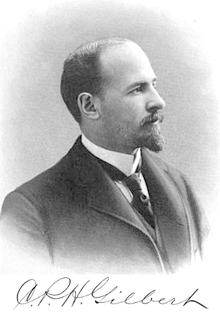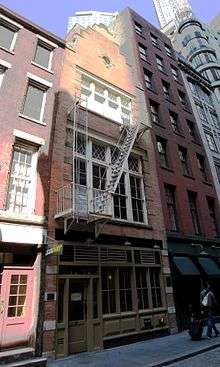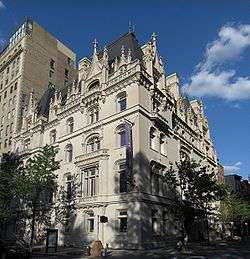C. P. H. Gilbert
Charles Pierrepont Henry Gilbert (August 29, 1861 in New York City[1] – October 25, 1952[2]), most often referred to as C. P. H. Gilbert,[3] was an American architect of the late-19th and early-20th centuries best known for designing townhouses and mansions.
- For another American architect with a similar name, see Cass Gilbert.
C. P. H. Gilbert | |
|---|---|
 Gilbert circa 1900 | |
| Born | Charles Pierrepont Henry Gilbert August 29, 1861 Manhattan, New York City |
| Died | November 25, 1952 (aged 91) |
| Nationality | American |
| Occupation | Architect |
| Buildings | Harry F. Sinclair House Joseph Raphael De Lamar House Morton F. Plant House Felix M. Warburg House Otto H. Kahn House |
Background and early life
Gilbert's family comes of English and New English ancestry. One of the members was Sir Humphrey Gilbert, to whom Queen Elizabeth I of England granted a patent for the colonization of North America. Sir Humphrey's ambitious plans ended when he was lost at sea with most of his company on his return voyage from the exploration of Newfoundland. Other members of the family, however, soon planted the name in North America.[1]
His father was Loring Gilbert, a direct descendant of John Gilbert, the second son of Giles Gilbert of Bridgwater, Somerset, England, who came to America early in the 17th century and settled at Dorchester, near Boston, and died at Taunton, Massachusetts, in 1654. Loring Gilbert was a leading commission merchant who had a successful career. He married Caroline C. Etchebery, and they had one son, Charles Pierrepont Henry Gilbert. Loring Gilbert died in 1893.[1]
C. P. H. Gilbert received a careful education, studying both in America and in Europe, such as the École des Beaux-Arts in Paris. After being prepared for college he took special courses in civil engineering and architecture, and later studied painting, sculpture and the fine arts in general. After college, he began practical work as an assistant in the office of a prominent firm of architects, where he received the training necessary to prepare him for engaging in his own business.[1] As a young man he designed buildings in the mining towns of Colorado and Arizona before returning to New York around 1885.
Career
In 1886, at the age of twenty-five, Gilbert began practicing as an architect in New York City, and received commission to design buildings of all kinds. One of Gilbert's first projects was the design of fourteen brownstone rowhouses that now form a part of the Manhattan Avenue Historic District. Gilbert designed the block for Hoboken developer John Brown in 1886.[4]
Another noteworthy building was the 1888 Richardsonian Romanesque mansion at Eighth Avenue and Carroll Street in Park Slope, Brooklyn for Thomas Adams Jr., a chewing gum magnate. From 1893 on, Gilbert had a very large business, which grew steadily. In addition, he was a director or a stockholder in a number of large manufacturing companies outside of New York.
He saw action during the Spanish–American War of 1898.[5] After the war he returned to New York.
By 1900 Gilbert had a reputation as a specialist in designing opulent townhouses and mansions. Among Gilbert's Fifth Avenue palazzi is the 1905 Neo-Renaissance mansion of Morton Freeman Plant, son of railroad tycoon Henry B. Plant. Through the 1920s he designed more than 100 New York City mansions in various styles; several of them along Fifth Avenue have now been re-purposed for institutional use. In education, client list and architectural style, Gilbert largely followed in the footsteps of Richard Morris Hunt, whose petit château on Fifth Avenue for William Kissam Vanderbilt set a model for French Late Gothic limestone châteaux to house the elite of the Gilded Age.[6] Amongst Gilbert's clients were wealthy and influential industrialists and bankers such as Harry F. Sinclair, Joseph Raphael De Lamar, Felix M. Warburg, Otto H. Kahn, Adolph Lewisohn, Augustus G. Paine, Jr. and families such as the Baches, Reids, Wertheims, Sloanes and other.[7] Gilbert also designed a number of mansions and buildings on Long Island and in upstate New York in the 1920s.[7]
Gilbert retreated from public life, and by the late 1920s stopped designing any new houses. He retired to Pelham Manor, New York in Westchester County, where he died on October 25, 1952 at his home on 216 Townsend Avenue, at the age of 92.[2][5][8] He is interred at Woodlawn Cemetery in The Bronx, New York City.
Memberships
Gilbert was a member of numerous professional and social organizations, amongst them the Chamber of Commerce of the State of New York, the Architectural League, the Society of Colonial Wars, the General Society of the Sons of the Revolution, the New England Society, and the Fine Arts, Metropolitan, Union League, Lawyers', Riding, Racquet, Ardsley, Colonial, Country, and Nassau Country clubs of New York. He also was a Fellow of the American Institute of Architects, and a veteran of Squadron A, the cavalry organization of the New York National Guard.[1]
Family
Gilbert was married to Florence Cecil Moss, daughter of Theodore Moss of New York City, and had two children: Dudley Pierrepont Gilbert and Vera Pierrepont Gilbert.[1] He lived at 33 Riverside Drive and had a villa in Newport, Rhode Island at Ochre Point.[9]
Works
Some of Gilbert's works include:
- 1881 – Jules S. Bache residence, 10 East 67th Street,[10] remodeled in 1889.[11]
- 1886 – Fourteen brownstowne rowhouses in the Manhattan Avenue Historic District: 120-40 Manhattan Avenue, 39-43 West 105th Street, 38-44 West 106th Street
- 1888-1904 – at least eight of the Montgomery Place mansions (#11, 14, 16-19, 21, 25, 36-50, 54-60), between 8th Avenue and Prospect Park, Brooklyn[7]
- c.1889 – 313 and 315 Garfield Place, Brooklyn. Contrasting speculative houses.[7]
- c.1890 – Joseph Hanan residence, Carroll Street and 8th Avenue, Park Slope, Brooklyn; demolished in the 1930s[7]
- c.1895 – three adjoining mansions at the foot of Riverside Drive: 311 West 72nd Street, 1 Riverside Drive and 3 Riverside Drive for Philip Kleeberg[7]
- 1898 – Harry F. Sinclair House, 79th Street and Fifth Avenue, now housing the Ukrainian Institute
- 1898 – Cushman Building, Broadway and Maiden Lane, 1898 (previously the site of the Howard Hotel)
- 1900 – "Meudon", the massive 80-room Louis XVI-style revival Gold Coast estate of William Dameron Guthrie in Lattingtown
- c.1900 – Franklin Winfield Woolworth mansion, 80th Street and Fifth Avenue; demolished[7]
- c.1900 – Edmund C. Converse residence, 3 East 78th Street, in a "suave neo-Gothic", according to Christopher Gray;[12] Converse was the first president of the Bankers Trust Company; his Greenwich, Connecticut estate is now known as Conyers Farm
- 1903 – 57 Stone Street, built in the Dutch Colonial Revival style for Amos F. Eno, a son of Amos R. Eno
- 1904 – The Knabe Building, 437 Fifth Avenue
- 1905 – Joseph Raphael De Lamar House, Madison Avenue and 37th Street, now the Polish Consulate General
- 1905 – Morton F. Plant House, 52nd Street and Fifth Avenue, with architect Robert W. Gibson, now Cartier
- 1906-1908 – Felix M. Warburg House, 92nd Street and Fifth Avenue, now the Jewish Museum
- 1913-1914 – Charlcôte House in Flat Rock Camp, constructed for Charlotte M. Bedell Paine; demolished 1980s
- 1914-1916 – Weckesser Hall, Wilkes University, Wilkes-Barre, Pennsylvania[13]
- 1916-1918 – Otto H. Kahn House, 91st Street and Fifth Avenue, with architect J. Armstrong Stenhouse, now the Convent of the Sacred Heart
- 1917 – Adolph Lewisohn residence, 9 West 57th Street, demolished[14]
- 1917 – 1067 Fifth Avenue, near 87th Street, apartment design in the French Gothic style[7]
- 1917-1918 – Augustus G. Paine, Jr. residence, 31 East 69th Street, now Austrian Consulate General[15]
- 1919-1921 – Arthur and Alice Sachs residence, 42 East 69th Street, now Jewish National Fund[16]
- 1921 – Essex County National Bank, Willsboro (founded in 1923 by Augustus G. Paine, Jr., today part of Champlain National Bank)[17]
- 1924-1925 – Seymour H. Knox II House, Buffalo, New York[18]
- 1929-1930 – Paine Memorial Library, Willsboro[19]
- Harry F. Sinclair House on Fifth Avenue, as seen from 79th Street, now the Ukrainian Institute (1898)
 57 Stone Street, constructed for Amos F. Eno (1903)
57 Stone Street, constructed for Amos F. Eno (1903)- Morton F. Plant House, 52nd Street and Fifth Avenue, now Cartier (1905)
 Joseph Raphael De Lamar House, Madison Avenue and 37th Street, now the Polish Consulate General (1905)
Joseph Raphael De Lamar House, Madison Avenue and 37th Street, now the Polish Consulate General (1905) Felix M. Warburg House, 92nd Street and Fifth Avenue, now the Jewish Museum (1906–08)
Felix M. Warburg House, 92nd Street and Fifth Avenue, now the Jewish Museum (1906–08) Otto H. Kahn House, 91st Street and Fifth Avenue, now the Convent of the Sacred Heart (1916-1918)
Otto H. Kahn House, 91st Street and Fifth Avenue, now the Convent of the Sacred Heart (1916-1918)- Residence of Augustus G. Paine, Jr., 31 East 69th Street, now the Austrian Consulate General (1917–18)
- Residence of Arthur and Alice Sachs, 42 East 69th Street, now the Jewish National Fund (1919–21)
References
- Harrison, Mitchell Charles, ed. (1902), "Charles Pierrepont Henry Gilbert", Prominent and Progressive Americans: An Encyclopædia of Contemporaneous Biography, 1, New York: The Tribune Association, pp. 132–133
- Pearson, Marjorie. "Gilbert, C(harles) P(ierrepont) H." in Jackson, Kenneth T., ed. (1995). The Encyclopedia of New York City. New Haven: Yale University Press. ISBN 0300055366., p.467
- He was also sometimes referred to as "Charles Pierrepont H. Gilbert", as in his New York Times obituary.
- Postal, Matthew A.; Most, Jennifer L. et al. "Manhattan Avenue Historic District Designation Report" New York City Landmarks Preservation Commission (May 17, 2007)
- "Obituary Charles Pierrepont H. Gilbert". New York Times. October 27, 1952. Retrieved December 4, 2010.
- Craven, Wayne. Gilded Mansions: Grand Architecture and High Society (2008) p. 310.
- Gray, Christopher (February 9, 2003). "Streetscapes/Charles Pierrepont Henry Gilbert; A Designer of Lacy Mansions for the City's Eminent". New York Times. Retrieved November 14, 2010.
- Hasbrouk, Charles et al. "West End Collegiate Historical District Designation Report" Archived 2010-06-07 at the Wayback Machine New York City Landmarks Preservation Commission (January 3, 1984), pp.256-257
- Staff (September 16, 1909). "Miss Vera Gilbert engaged" (PDF). The New York Times. Retrieved December 3, 2010.
- Calderone, Michael (July 26, 2006). "A $32 Million Townhouse Sells on East 67th". The New York Observer. Retrieved November 14, 2010.
- Maher, James T. The Twilight of Splendor (1975) p.336
- Gray, Christopher (December 23, 2007). "Where Historic Town Houses Still Hold Court". New York Times. Retrieved November 14, 2010.
- Manley, Bill (2011). "History". Archived from the original on November 30, 2010. Retrieved January 26, 2011.
- Interiors were decorated by Hofstatter and Baumgarten and featured in House and Garden 1917 (John F. Pile, A History of Interior Design 2005:316).
- Doane, Ralph Harrington (May 1919). "The Residence of Augustus G. Paine, Esq". The Architectural Review. New York: The Architectural Review, Inc. VIII (5): 123–126.
- Pearson, Marjorie et al. "Upper East Side Historic District Designation Report v.1" New York City Landmarks Preservation Commission (May 19, 1981) p.414
- "Architecture of the Champlain Valley, Willsboro" (PDF). Adirondack Architectural Heritage. 2010. Archived from the original (PDF) on October 25, 2010. Retrieved November 1, 2010.
- "History - Samuel H. Knox Jr. House"
- "History". Paine Memorial Library. 2010. Retrieved November 14, 2010.
External links
| Wikimedia Commons has media related to C. P. H. Gilbert. |
- Pictures and Information on C.P.H. Gilbert's Historic Long Island Commissions
- emporis page with list of commissions
- Convent of the Sacred Heart architectural records, 1902-1918. Held by the Department of Drawings & Archives, Avery Architectural & Fine Arts Library, Columbia University.
- Mausoleum for William Rockefeller (Sleepy Hollow Cemetery, Mount Pleasant, N.Y.). Held by the Department of Drawings & Archives, Avery Architectural & Fine Arts Library, Columbia University.